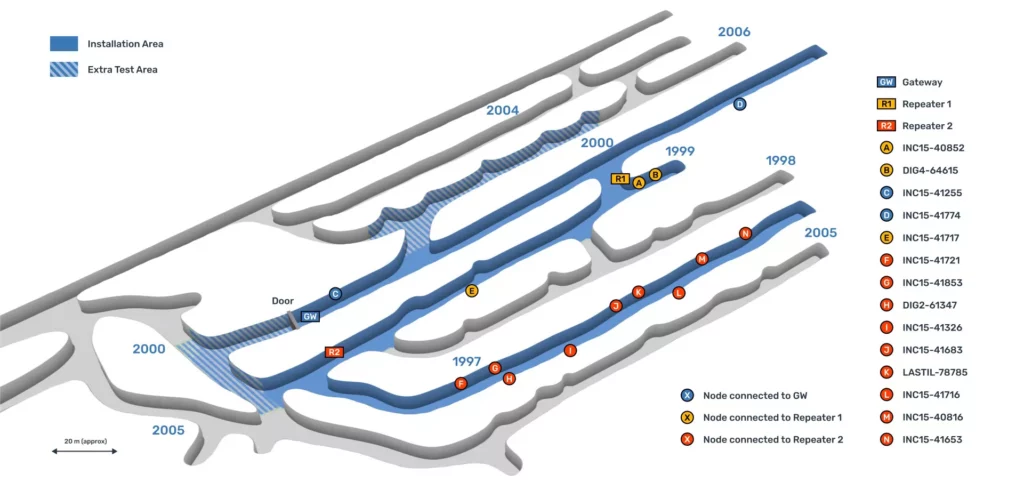How LoRa Tree enhances underground communications
Challenge
Deep mines are among the most challenging work environments in the world. Workers can operate at depths of more than a kilometer underground, where any accident can put lives at risk. Monitoring the state of heavily loaded mine walls is critical, but not easy. Traditionally, mining companies rely on human engineers to read and record the data from geotechnical sensors underground. This means that readings can only be carried out sporadically, with data being made available for analysis with gaps of days or even weeks. As well as requiring qualified technicians, this method of data collection can be prone to human error and results in incomplete analyses, with little scope for detecting fast-moving faults.
The introduction of wireless technologies has been an important breakthrough in underground mining, allowing mines to do away with manual readings and detect possible risks in a robust, cost-effective manner. However, the intricate topologies of underground environments hinders effective data transmission. Tunnels, turns, multiple levels and long galleries cause networks to lose radio strength and data reliability. Gateways, which need internet connectivity to stream data out of the mine to control centers, cannot be installed deep in mines because internet connections are not usually available. This makes it hard for engineering firms to deploy robust, cost-effective monitoring solutions underground.
Mine Design Technologies (MDT), an Ontario, Canada-based geotechnical instrumentation leader, was keen to offer its mining customers a better option—and partnered with Worldsensing for success.
Solution
MDT was already familiar with Worldsensing technology for open-pit mining environments. In these, Worldsensing’s LoRa long-range, low-power communications is able to achieve wireless data transfer over distances in excess of six kilometers.
In early 2023, Worldsensing launched a LoRa tree network topology. This network topology can extend the radio communication range of an existing LoRa network. The key component of this network topology is the K20 edge repeater. The repeater is able to receive a signal from a node and retransmit it to a gateway in data hops. Repeaters can be placed strategically to overcome radio signal obstacles such as walls, ramps and curves.
With the launch of Worldsensing’s LoRa tree network, MDT and Worldsensing partnered to deploy a monitoring system in the Norcat Underground Centre, a live mine used for research and development in Sudbury, Ontario. Figure 1 illustrates the field tests performed. The objective was to push the limits of the LoRa tree network and allow nodes far away from the gateway to transmit data with minimum data loss.
The network consisted of 14 nodes, connected to two in-place inclinometers, 11 tiltmeters and one laser tiltmeter, spread out in three 200-meter-long, interconnected drives. The deployment started out in section 1999 with the installation of repeater 1 (R1). R1 was able to retransmit the data back to the gateway installed at the entrance of the mine with an excellent radio signal. The deployment rapidly continued further away from the gateway with a second repeater (R2) at the beginning of section 1999. R2 was able to circumnavigate the turns leading to section 1997 and transmit data from the nodes installed there.

Figure1: NORCAT underground layout. The deployment included 14 edge devices distributed in three diferent galleries. The nodes transmitted data back to the gateway using a LoRa Tree network topology using two K20 Edge Repeaters
Results
The Norcat deployment yielded the following results:
- The deployment was able to transmit data from 14 nodes, located at different sections, using only two repeaters.
- The LoRa tree network provided coverage with a 0.5% transmission loss, which is considered optimal in radio communication.
- Repeaters in the LoRa tree topology do not have to be facing the gateway directly for effective radio transmission. This allows for a greater radio coverage with minimum deployment of repeaters.
- All Worldsensing data loggers connected easily to the network, underscoring the compatibility of the Worldsensing device portfolio with a LoRa tree topology
- Underground connectivity up to 200m in complex underground environment
Benefits
Despite some teething problems adapting the technology to North American regulations, the initial results have been outstanding, with data being transferred flawlessly across the entire deployment area. Only one packet of data has been lost since the start of the trial, during the deployment phase, and MDT’s technicians were able to explain how and why that happened.
Worldsensing is the leading provider of geotechnical monitoring network technology, with an unrivaled array of product integrations that allows its networks to operate with most leading sensor and data visualization providers. This flexibility is already being used to help improve geotechnical monitoring and infrastructure safety in above-ground environments. The collaboration with MDT has shown how repeaters can extend Worldsensing’s leading functionality underground.
The site is available for visits. If you are interested please contact us at [email protected]
Are you planning a project?
Get in touch with us to share your needs and project requirements. We are experts in engineering and IoT and are happy to help.